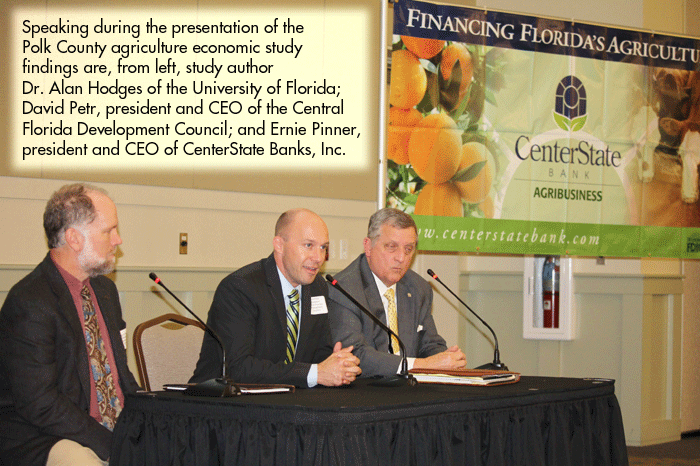| The Polk Agriculture Economic Impact Study reveals ag as an economic pillar |
NEARLY HALF of Polk County’s land remained in farm use in 2012, although acreage declined nearly 17 percent the preceding decade. “The traditional industries of production agriculture and mining have been gradually declining over the last ten years,” according to a new economic impact report commissioned by the Polk County Farm Bureau. “While active phosphate mining concluded in 2014, the industry continues to make capital investments in fertilizer production facilities, which generate significant amount of labor income, property income, and tax impacts for the County.”
The study by Dr. Alan Hodges, a scientist with University of Florida/Institute of Food and Agricultural Sciences (UF/IFAS) in Gainesville, and Dr. Thomas Stevens, a UF/IFAS research associate, was the topic of a summit on February 26. It shows agriculture and natural resource industries had an estimated $14.38 billion economic impact in 2012 in Polk, and resulted in 86,023 jobs, more than 33 percent of total employment.
“The study brings to light how significant agriculture is to our economy,” concludes PCFB President Kyle Story. “We need to take our role as stewards of the land and an economic force in the county very seriously. We need to be aware of who we are and be proud of it and work hard for it.”
“This study reaffirms the significance of agribusiness in Polk County, and validates our focus on this industry for business recruitment and expansion,” says David Petr, president and chief executive officer of the Central Florida Development Council in Auburndale. “What impressed me about this study was not only the benchmark data, but the insight it provided so that the industry can be prepared for the changes ahead. With the power of the Farm Bureau behind us, we will use this insight as industry leaders and continue to accomplish great things in Polk County.”
The report reveals about 520,899 acres, or 45 percent of the county’s total land area, was farmland in 2012. Farm acreages declined by 105,735 acres from 2002 to 2012; population increased nearly 23 percent to more than 616,000.
Polk County, which was established in 1861 and named after the 11th U.S. president, James Polk, is the fourth largest county in Florida when ranked by land area. It measures 1,798 square miles.
Despite the decline, Polk still ranked well statewide and nationally for agricultural commodities. “Polk County is notable in being a top-ranked county in both Florida and the U.S. for the production of oranges and grapefruit. It is also one of the top five counties in the state for the production of cattle and calves, aquaculture, honeybee colonies, and goats,” the report states.
The agriculture, natural resources, and food-related industry group was the largest major industry group countywide in 2012, representing $36 billion in total sales or 25 percent of all industry sales. This sector provided 46,365 jobs, 18 percent of all jobs, the report states.
“It looks like the decline has been in place since before the advent of citrus greening in Florida. The decline in citrus acreage has been very uniform since 2002,” asserts Dr. Hodges. “If you drive down Highway 27 in Polk, you see that very clearly, development everywhere. I was really shocked by it.”
Growth in food manufacturing and distribution has—at least for now—been making up for it. Revenues and employment by production agriculture, mining, and nature-based recreation industries declined in Polk between 2001 and 2012, while activities related to agricultural inputs and services, food manufacturing, and food distribution grew. The number of jobs in agricultural inputs and services rose 19.4 percent between 2001 and 2012, the report shows. “It seems to be working for them. There are threats on the horizon that could lead to diminished economic activity in the future,” he says. The study also found:
• Polk County is popular with the 65-plus set, which may at least partially account for why job growth hasn’t kept pace with population. “Compared to Florida, the county continues to attract a higher proportion of residents 65 years of age and older,” the study states. “Polk County also serves as a bedroom community for Orlando and Tampa, with about 25,000 more residents commuting to jobs outside the county than non-residents commuting into the county for work.”
• Real estate, tourism, and other service sectors have increased their role in the economy.
• Total personal income has risen in Polk County from $12.86 million in 2002 to $22.02 million in 2012, earning a boost in rank from 12th to ninth in the state. Per capital personal income was $35,746 in 2012, below the state’s average $41,012. It was up from $25,654 in 2002.
• In addition to food production, fiber and fuel, agriculture supplies some less tangible benefits: Green space, scenic vistas, wildlife habitat, as well as air and water purification. “These are amenities that make Polk County an attractive place to live, work, and play,” the study shows. “Agricultural lands are usually net contributors to the budgets of local governments, because they demand relatively few municipal services. These factors must all be carefully considered when making future land-use planning decisions.”
The study relied on U.S. Census and other government data. PCFB also commissioned studies in 1999 and 2006 that spell out the importance of agriculture to the community. The 2006 study by Stewardship America, Inc. showed the county would lose $1.85 billion in annual sales if agriculture were to disappear, along with 20,290 jobs. Sixty-four percent of revenues were generated by the citrus industry. The 1999 study by Florida Stewardship Foundation showed additional tax revenues collected on developed land were not sufficient to cover the cost of increased services. Every $1 generated in the residential sector resulted in $1.89 in expenditures. By comparison, every $1 generated by agriculturally-related activities incurred expenses of eight cents.
CREDIT
article by CHERYL ROGERS

